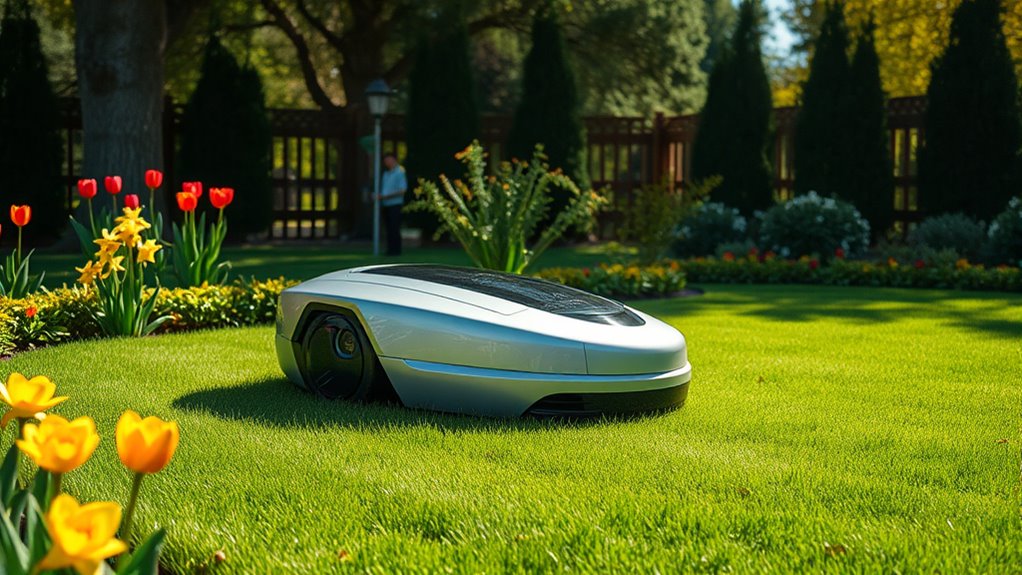Robot lawn mowers are shaping the future of yard maintenance by offering autonomous, eco-friendly solutions that save you time and effort. Advancements in AI, IoT connectivity, and sensors make them smarter, safer, and more efficient. They adapt to your yard’s layout, navigate obstacles, and even schedule mowing around weather. With growing demand worldwide, these innovations are making lawn care easier and more sustainable—if you’d like to explore how they can transform your yard, there’s more to discover.
Key Takeaways
- Increasing adoption driven by technological innovations like AI, IoT, GPS, and sensors enhances autonomous and efficient yard maintenance.
- Growing global market projected to nearly triple by 2033, reflecting rising consumer demand and industry growth.
- Eco-friendly electric models reduce noise and emissions, aligning with sustainability trends in outdoor care.
- Advanced safety and convenience features, such as obstacle detection and autonomous scheduling, improve user experience.
- Regional adaptations and affordability improvements expand access, making robotic mowers a future standard in yard maintenance.

Have you ever wondered how robotic lawn mowers are transforming yard maintenance? These innovative devices are rapidly gaining popularity, with the market valued at around USD 8.21–8.47 billion in 2024. Experts predict this figure will nearly triple, reaching USD 21.97 billion by 2033. This growth reflects a compound annual growth rate (CAGR) between 9.9% and 14.9%, driven by increasing consumer adoption and continuous advancements in automation and AI. You’ll notice the market expanding from about USD 1.36 billion in 2024 to over USD 2.26 billion by 2029, indicating a strong, sustained rise in popularity. The global market size is projected to reach $1.52 billion in 2025.
Technological innovations are a major reason for this surge. AI integration allows robotic mowers to navigate autonomously, avoiding obstacles with precision and adapting to changing conditions. IoT connectivity lets you monitor and control your mower remotely, scheduling mowing sessions based on weather forecasts or your personal preferences. Sensors such as boundary wires and tilt sensors enhance safety and operational accuracy, preventing accidents or damage. Manufacturers are also introducing modular designs, offering multifunctional capabilities like leaf blowing and watering modules, making these devices even more versatile. GPS features and remote controls further simplify operation, enabling you to track your mower easily and adjust settings from anywhere. Additionally, user-friendly interfaces and adaptive learning algorithms improve efficiency by helping the mower optimize its path over time.
Market growth is fueled by several key factors. Rising disposable incomes and shifting consumer behaviors mean more homeowners are investing in automated solutions. An aging population and increasing labor costs make robotic mowers an attractive alternative to traditional lawn care. Competition among manufacturers sparks ongoing innovation, leading to a diverse array of models with advanced features. Additionally, there’s a growing awareness of eco-friendly options—electric robotic mowers produce less noise and emissions compared to gas-powered alternatives. As outdoor living and gardening become more popular, demand for automated lawn care solutions continues to rise.
Regionally, markets like Saudi Arabia, the UAE, and South Africa show especially high demand. Emerging markets are quickly adopting robotic mowers as affordability improves and technology becomes more accessible. Developed countries are focusing on upgrading their existing lawn care setups with smarter, more integrated models. Manufacturers are also designing region-specific features, such as climate adaptation, to cater to diverse environments.
Safety and convenience features play a vital role in user confidence. Advanced safety mechanisms reduce injury risks, while autonomous scheduling software adjusts mowing based on weather conditions. Self-docking and rain sensors allow for nearly hands-free operation, and obstacle detection sensors protect your property and equipment. All these features combine to save you significant time and effort.
Finally, robotic mowers are environmentally friendly, reducing carbon footprints and noise pollution. They promote sustainable gardening by ensuring consistent, precise maintenance. As the market continues to grow, these devices will become even more sophisticated and integral to modern yard care, making them a smart choice for homeowners and landscapers alike.
Frequently Asked Questions
How Do Robot Lawn Mowers Handle Uneven Terrain?
You might wonder how robot lawn mowers handle uneven terrain. They use all-wheel drive and rugged, treaded wheels to gain better grip on slopes and rough patches. Pendulum-suspended decks help blades adapt to ground contours, ensuring an even cut. Sensors detect bumps and obstacles, guiding navigation to prevent slipping or tipping. Advanced models can climb steeper inclines, maintaining performance and coverage even on challenging surfaces.
What Safety Features Do Robot Lawn Mowers Include?
Imagine a vigilant guardian patrolling your yard, always one step ahead. Your robot mower’s safety features act like this protector—infrared, ultrasonic, and camera sensors detect pets, obstacles, and hazards instantly. Boundary wires and GPS keep it within limits, while child safety keys and anti-theft alarms prevent misuse. Drop sensors and weather detection guarantee it navigates safely around stairs and rain, giving you peace of mind with every mow.
Can Robot Mowers Be Used on Slopes Over 20 Degrees?
You wonder if robot mowers can handle slopes over 20 degrees. Many models manage slopes up to 20-30 degrees without issues, while high-end versions can handle steeper inclines, even up to 45°. To guarantee safety and performance, check your mower’s specifications and slope limits. Proper installation, terrain assessment, and choosing the right model will help you mow efficiently on steeper slopes without risking damage or uneven cuts.
How Energy-Efficient Are Robotic Lawn Mowers Compared to Traditional Ones?
You might wonder how energy-efficient robotic lawn mowers are compared to traditional ones. They typically use only 0.5 to 2 kWh weekly, much less than gasoline-powered mowers, which consume about 12.6 kWh. They run on electricity, meaning you’re reducing greenhouse emissions and saving money—often less than $1 monthly. Their precise operation promotes healthier lawns, and overall, they use energy more efficiently, making them a smart, eco-friendly choice for yard care.
What Maintenance Is Required for Robot Lawn Mowers?
Did you know regular maintenance can extend your mower’s lifespan by up to 30%? To keep it running smoothly, you should clean the blades weekly, inspect wheels and sensors, and check the battery. Monthly, deep clean and update firmware. Annually, replace blades and check components. During winter, clean thoroughly, fully charge the battery, and store in a dry, protected area. Proper care guarantees peak performance and longevity.
Conclusion
In the end, embracing robot lawn mowers means you’re staying ahead of the curve and making yard work easier. They’re the smart choice for a tidy, well-maintained yard without breaking a sweat. While some may see them as a passing trend, they’re truly here to stay and revolutionize how you care for your outdoor space. Don’t let the grass grow under your feet—adopt this tech and keep your lawn in top shape; it’s a win-win situation.









